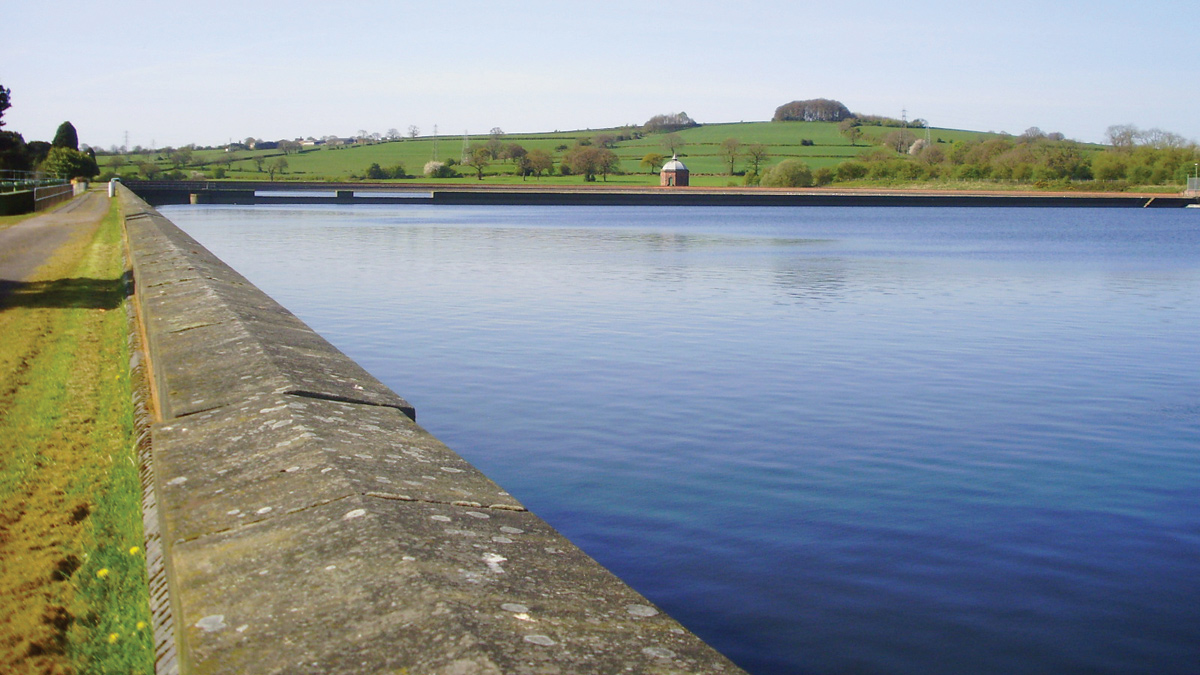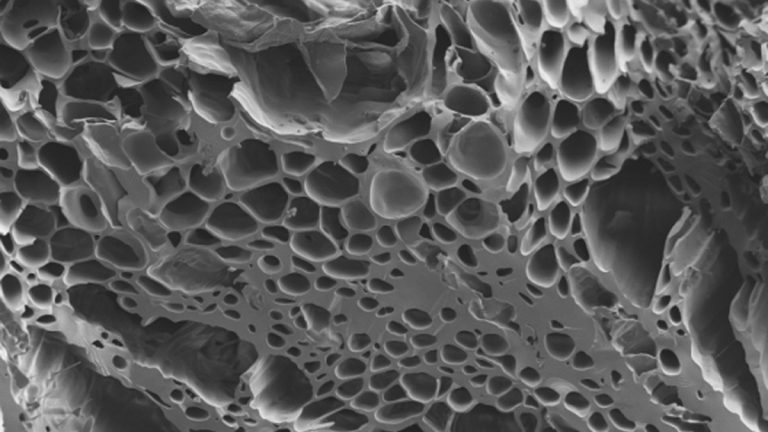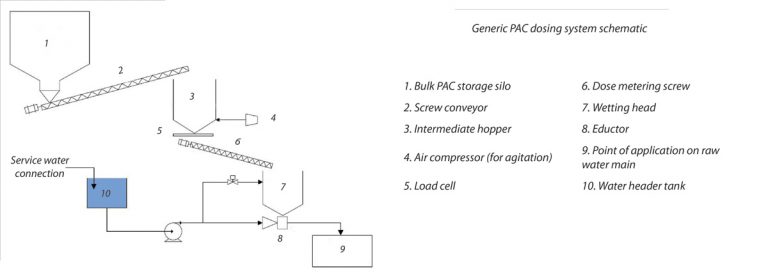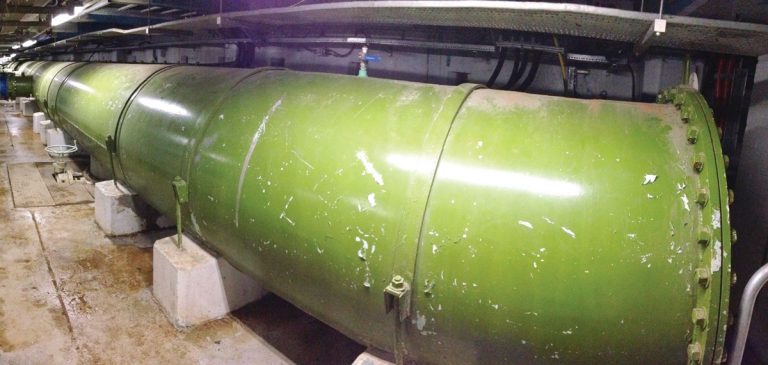BRP – PAC Dosing System – Birmingham Resilience Project (2017)

Frankley Reservoir - Courtesy of Severn Trent Water
Frankley Water treatment Works (WTW) provides a potable water supply to the metropolitan area of Birmingham, and has done so for over a century. Currently it treats water that is conveyed by gravity from the Elan Valley in Powys, Wales. Severn Trent Water is in the process of upgrading Frankley WTW to accommodate a new raw water source, abstracted from the River Severn in two locations and pumped to Frankley, as part of the wider Birmingham Resilience Project.
Background
The current treatment process employs DAF plant, rapid gravity filters (RGFs) and contact tanks for the required disinfection time before being fed into service. There is also a granular activated carbon (GAC) facility that is used intermittently to treat a blend of upland source water and river water. The additional process upgrade will enable treatment of river sourced water without the need to blend with upland water, thereby increasing the overall treatment capability and thus the resilience of the works.
Process options
The proposed process upgrade to Frankley is the addition of a third treatment stream that will utilise sand ballasted lamellas (SBLs) to provide river water treatment capability in conjunction with an additional batch of RGFs to provide further resilience. Flows are then directed to the existing works to complete the treatment process before to distribution into supply. A new sludge plant will also be constructed to handle the increased solids loading associated with the operation of the works when processing river water. The aim of this new processing stream is to be able to capably treat raw water from either the Elan Valley or the River Severn.
However, the aforementioned treatment processes are incapable of treating metaldehyde (used in pesticides) present at much higher concentrations in the river source. Three strategies for pesticide treatment were considered to meet pesticide removal targets.
- Using the existing GAC plant and regenerating the media after every EVA outage.
- Using advanced oxidation processes (AOP).
- Using powdered activated carbon (PAC) dosed through a variety of configurations including via a pipeline or a contact tank.
The GAC option was rejected on the grounds of its incapacity to deal with the flows needed and the requirement for the media to be regenerated after every outage. The energy and chemical input for an AOP solution proved to be cost prohibitive, once the volume of water to be treated was considered.
Hence, Severn Trent Water selected the use of PAC as an effective pesticide treatment method, and it is to be dosed through the raw water mains in order to provide a sufficient dosing time.

(left) New break pressure tank – Courtesy of Jacobs and (right) Existing GAC building – Courtesy of Severn Trent Water
PAC as an effective pesticide treatment
Activated carbon and the associated adsorption reactions forms the basis for many water treatment applications for the removal of taste, odour and volatile organic compounds as well as to prevent the formation of disinfection by-products. Adsorption is the process of accumulation of a substance at an interface; in the context of water treatment it is when contaminants gather at the solid-liquid interface. The carbon is processed to have small, low volume pores that result in a higher effective surface area available for adsorption and other chemical reactions. It can be applied in powdered form (PAC) or in a granular form (GAC) present in a bed configuration.
PAC has a greater flexibility when it comes to dose as it can be dosed at any location, which saves time and space. The dose can easily be changed to accommodate fluctuations in contaminate levels. It can become costly if it is used continuously as it cannot be regenerated and produces a quantity of sludge that must be dealt with. In contrast, GAC is the more economical choice when pesticides, tastes and odours need to be controlled on a more frequent basis in larger systems. However, the media eventually reaches a saturated adsorption capacity that means it must be regenerated or replaced by virgin GAC which can prove costly. Operation in river mode will occur infrequently, hence making the powdered form of activated carbon a much more appropriate choice.
Severn Trent was keen to consult the EA about the feasibility of PAC entering Frankley Reservoir. A variety of risks were considered to make sure that this really was the most effective way to remove pesticides under the new setup. The main concern was over settlement of the PAC in the reservoir and what danger this posed. However theoretical calculations and physical test work demonstrated good settlement of the PAC in the reservoir, having been injected some distance upstream, and any excess would be within the treatment capability of the downstream supplementary processes without any detriment to final water quality.

Electron microscope image of pores within activated carbon – Courtesy of Severn Trent Water
Another key concern was in relation to desorption of metaldehyde once the PAC had settled upon entering the reservoir basin. Metaldehyde can easily be desorbed from the active sites of the carbon, particularly at noticeable concentration differences between the bulk liquid and the adsorbed surface of the PAC. This is of particular concern when the transition back from river water occurs, due to very low concentrations of metaldehyde in the usual upland source water. Under normal running conditions the GAC is not in operation and as a consequence there would be no means of removing the desorbed pesticides once they have entered the treatment process. However, due to relatively low concentrations and high raw water turnover it has been determined that desorption will have little effect on the final water quality.
After thorough investigation and the consideration of all the factors, Severn Trent concluded that PAC dosing remained the most suitable and appropriate means for dealing with metaldehyde and other pesticides as part of the Birmingham Resilience Project.

Courtesy of Severn Trent Water
Contact time and dose rate
PAC will be administered at two locations within the raw water system. The first utilises the existing pumped route from the river (any effect of the PAC on the general wear-and-tear of the pumps is considered negligible) and the second is located on the break tank of the new raw water main currently being constructed as part of the Birmingham Resilience Project.
In order to determine the required contact time and dose rate, historic raw water data was provided from monitoring samples obtained from existing River Severn sites. This data showed that in order to treat pesticides effectively under the proposed option, design is to be based on reduction of a historic maximum concentration of 0.6mg/l (of metaldehyde) to a treatment target of 0.05mg/l.
The available contact time in the two mains varies due to differences in the distances the PAC-dosed water has to travel, and this was a key factor that had to be considered when Severn Trent Water, working in partnership with the Water Research Council, was investigating the required dosing rates. Two trials were carried out by WRc on behalf of Severn Trent Water to assess the PAC dose requirements encompassing both good and poor conditions of raw water quality.
A variety of commercially available PACs were tested, all of varying activities to determine which would be the most suitable given the raw water quality envelope and the available contact times. The tests yielded a design dose rate of the selected PAC (Chemviron Pulsorb WP260-90®) of 45mg/l for removal of metaldehyde under poor raw water quality conditions. Other PACs proved unsuitable for use along the new raw water main, purely due to the significantly high dose rates needed for the shorter contact time.
Dosing equipment
Severn Trent Water Ltd is to acquire 2 (No.) PAC dosing rigs to be installed in situ, both almost identical in operation however sized slightly differently to accommodate the variance in contact time. This ensures uniformity in the operability of these dosing systems.

Proposed POA location on the existing pumped River Severn main – Courtesy of Severn Trent Water
The rigs will include a storage silo, intermediate hoppers, screw conveyors, wetting heads and eductors at the point of application (POA), alongside the required water quality instruments and PAC dose measurement and sample points. An accompanying control system is to also be installed. The likelihood of the PAC settling out in the mains is considered negligible because, once wetted, the PAC has a density of between 1200-1400kg m-3 (whereas the density of the solids suspended in raw water is 2400kg m-3) and the velocity in both mains exceeds the critical deposition velocity of the PAC.
Looking ahead
The PAC dosing system is due to be installed and fully commissioned by late 2019, meaning that river water can enter Frankley Reservoir to begin the process of commissioning the new SBL process stream. Severn Trent Water is currently in the process of working with their raw water and treated water contractors in order to confirm a PAC supplier and progress the design to the next level of detail.





